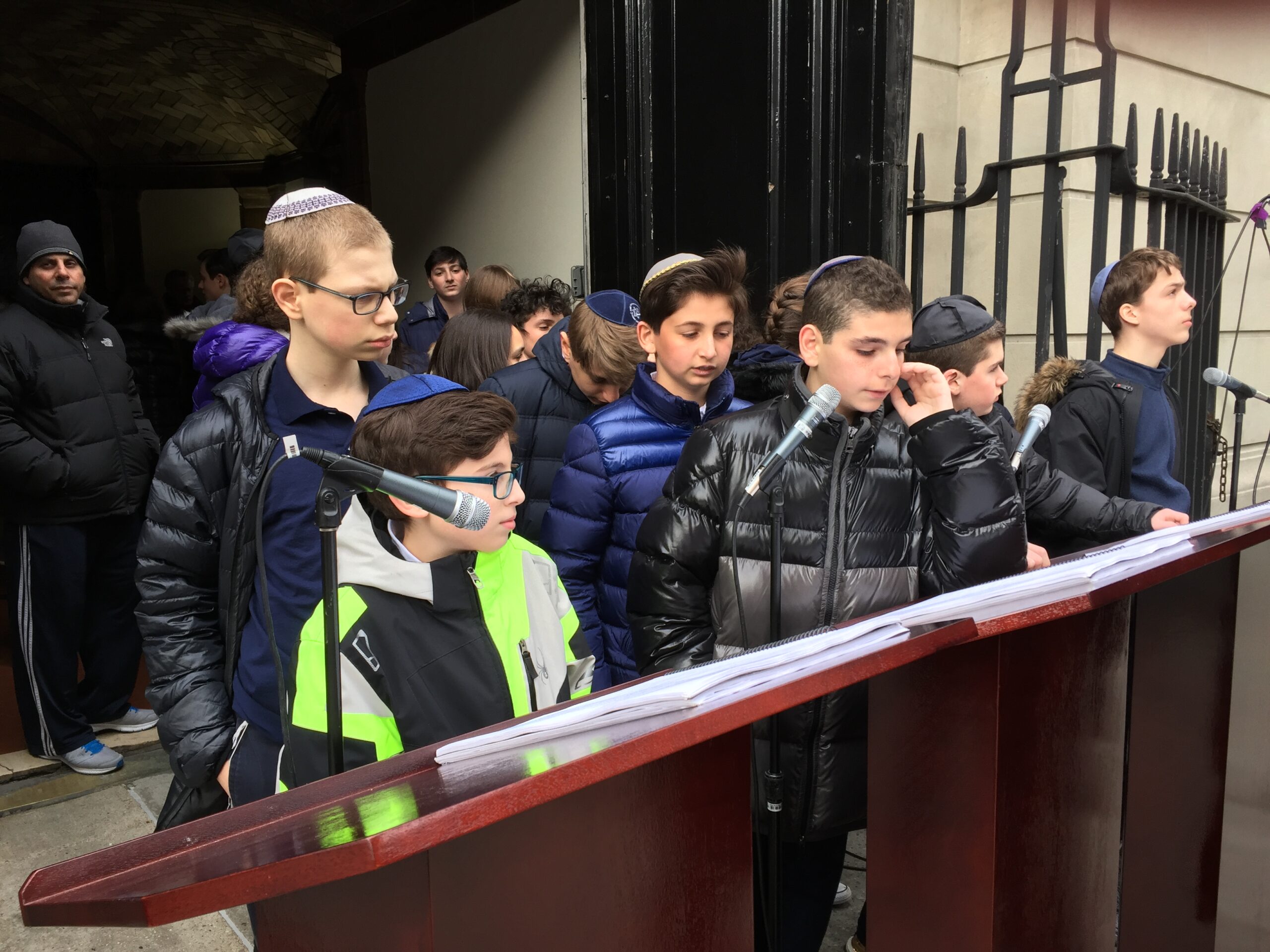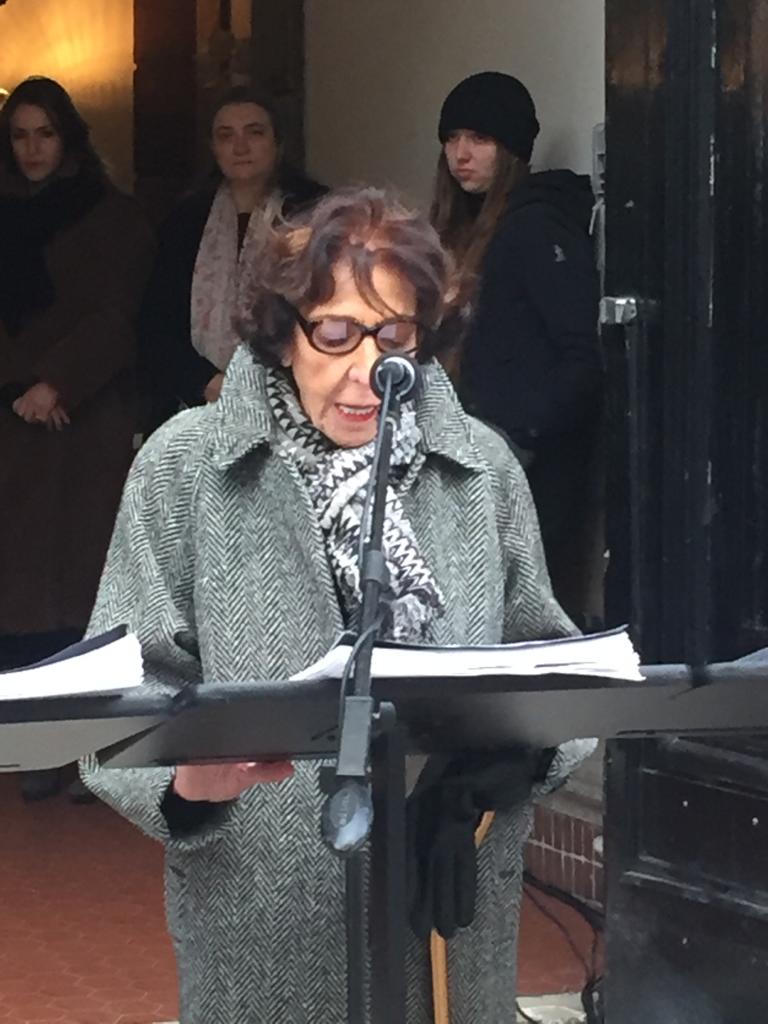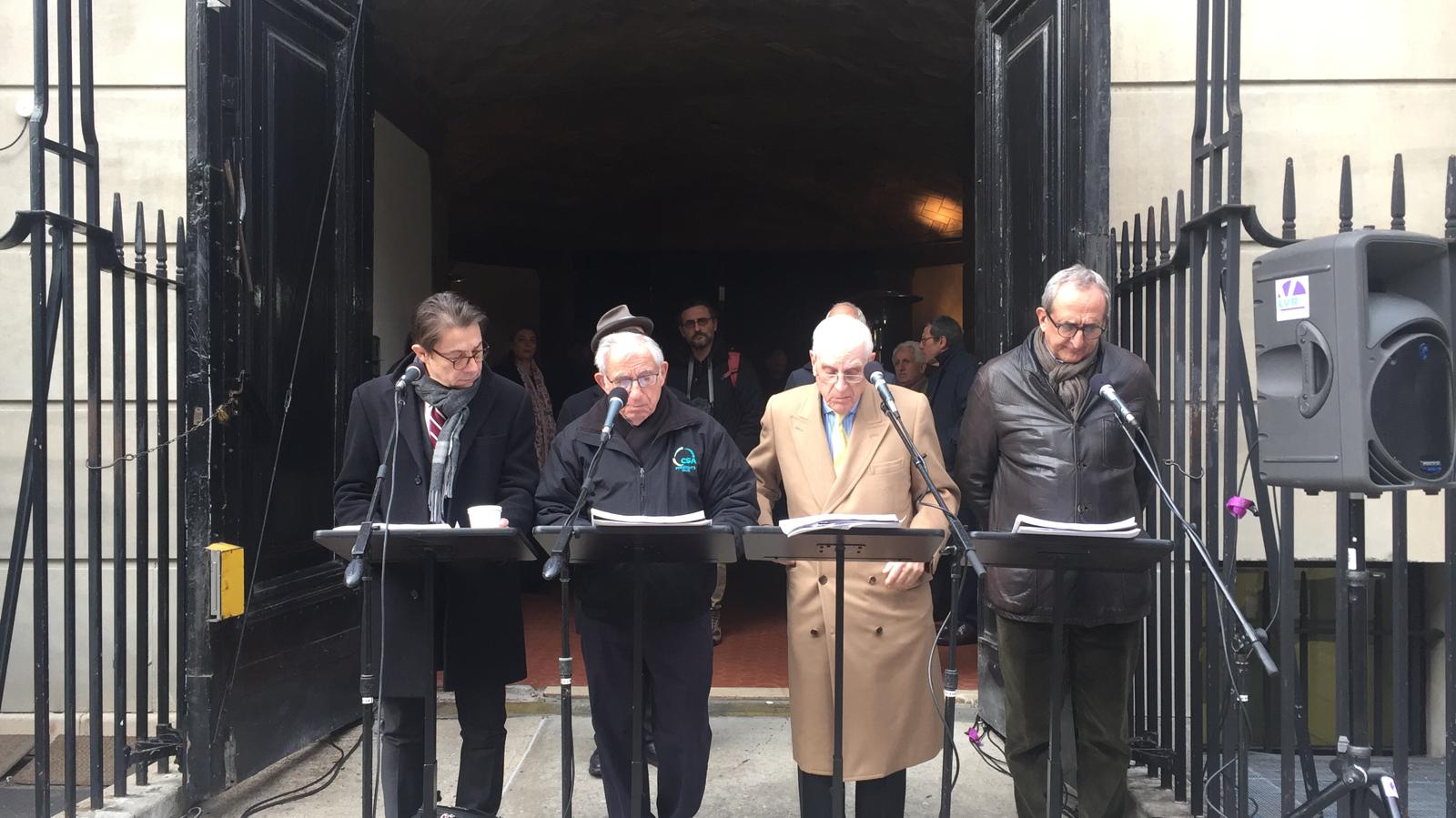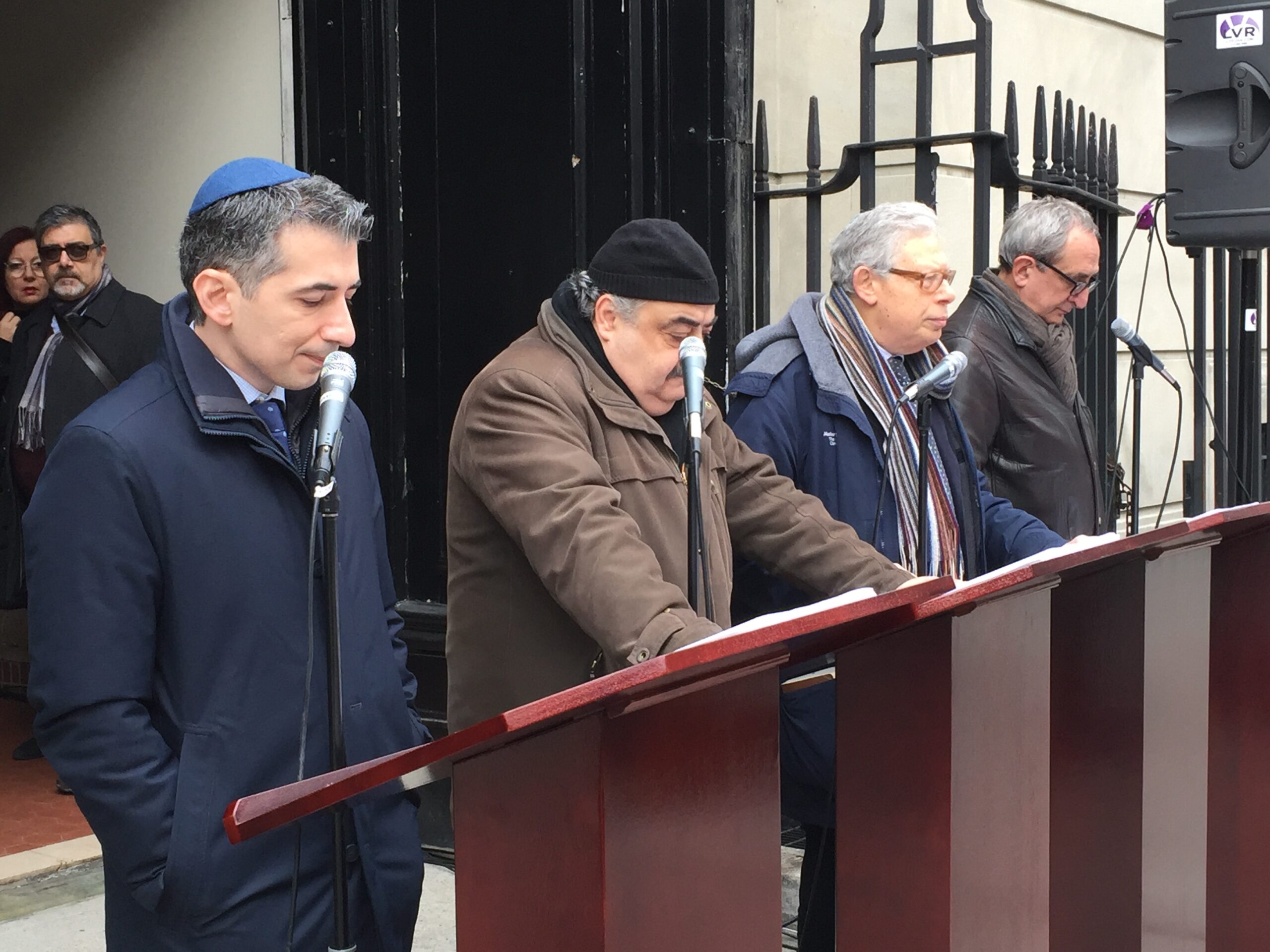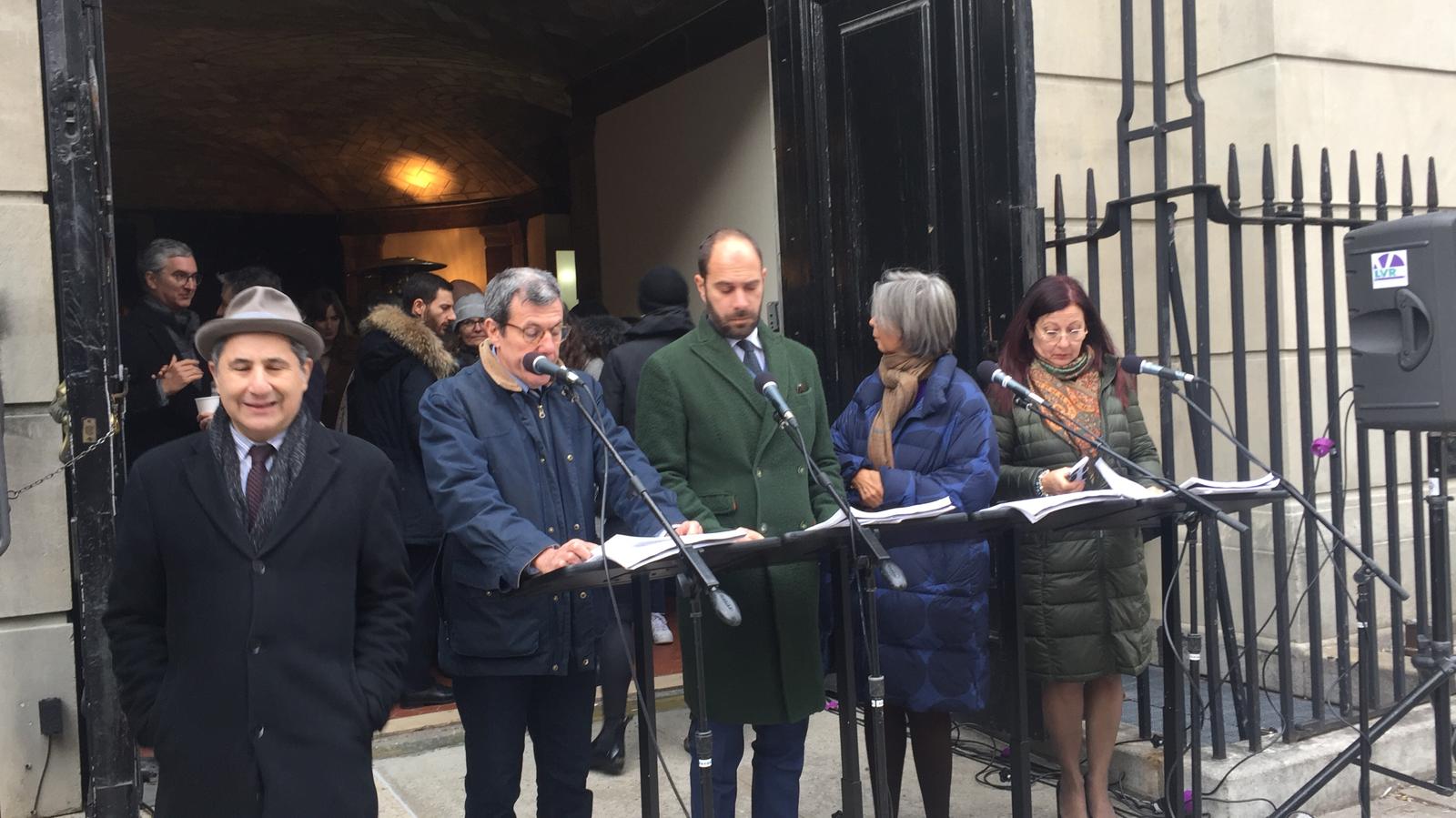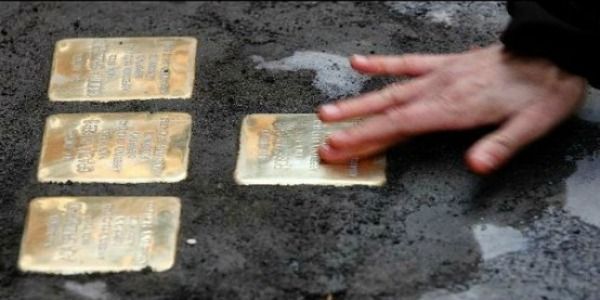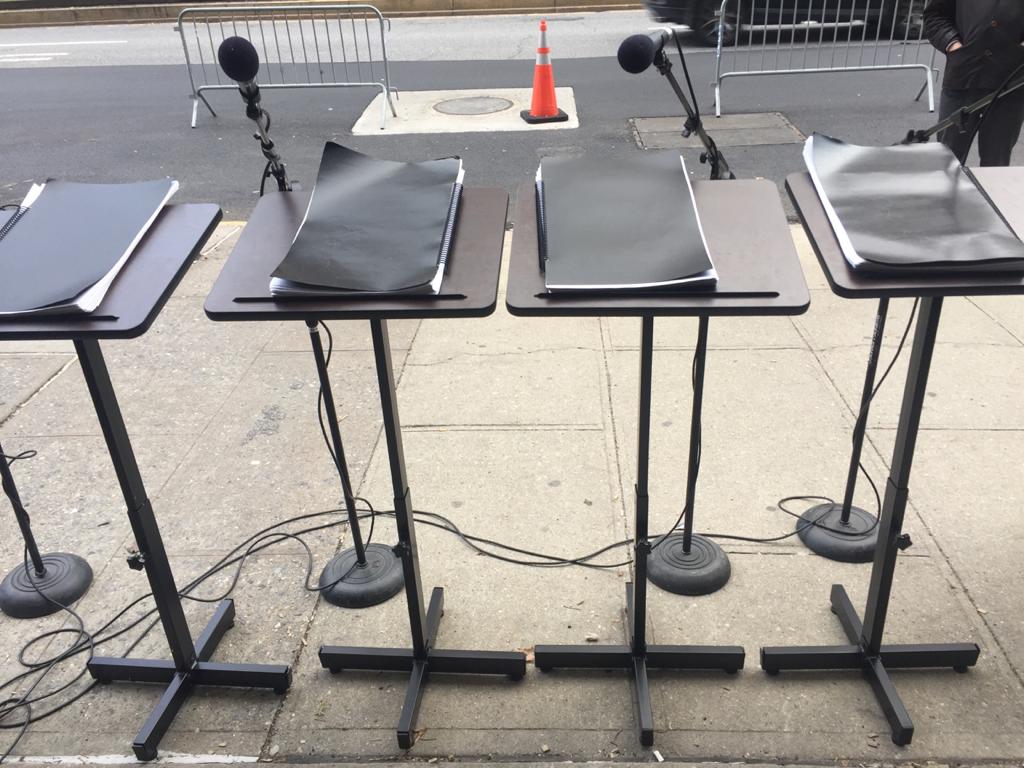GIORNO DELLA MEMORIA 2022 – NEW YORK
On January 27th, between 9:00 am and 2:00 pm, the Consulate General will host the ceremony of the reading of the names of the Jews deported from Italy and the Italian territories. The event is held in observance of International Holocaust Remembrance Day or Giorno della Memoria.
The public is invited to take part in the reading compatibly with the safety measures imposed by the Covid epidemic.
The event will take place outdoor in front of the Italian Consulate (690 Park Avenue between 68th and 69th street). Partners in the initiative are the Centro Primo Levi, the Italian Cultural Institute, Casa Italiana Zerilli Marimò at NYU, the Italian Academy at Columbia University, the Calandra Institute at CUNY, the Scuola d’Italia Guglielmo Marconi, Magazzino Art and the Center for Italian Modern Art (CIMA).
These institutions will offer a series of initiatives aimed at preserving the memory of the Nazi-Fascist past and educating the younger generations on the history of racism, discrimination, and the idea of supremacy.
Given the current circumstances, in order to protect the health of our invitees, the Consulate will require strict respect of the anti-COVID 19 protocols, including: distancing, masks, full vaccination proof or negative swab taken in the 24 hours before the event.
Please check this page before the event for updates on possible changes.
We look forward to seeing you on the 27th of January at the Consulate General of Italy, 690 Park avenue (between 69th and 70th St.) between 9:00 am and 2:00 pm.
SAVE THE DATE:
JANUARY 31 at 12 noon. Exhibiting the Holocaust and Strategies of Memory in Postwar Italy – Center for Italian Modern Art – Robert S.C. Gordon (Cambridge University, UK) and Raffaele Bedarida (Cooper Union, New York) will discuss their recent research on the memorialization of the Holocaust in the context of Italian public monuments and memorials. Prof. Gordon will examine the tensions and creativity that underpinned the creation of the Museo Monumento del Deportato in Carpi and the Memoriale italiano di Auschwitz, while Prof. Bedarida will focus on the Holocaust-related drawings by Corrado Cagli, a Jewish Italian artist who enlisted with the American army and took part in the liberation of the Buchenwald concentration camp. Register here.
FEBRUARY 1 at 5 pm. The Garden of the Finzi-Continis: the novel, the film, and the opera – NYU, Casa Italiana Zerilli Marimò with the Calandra Institute at CUNY. A conversation: Stefano Albertini (Casa Italiana Zerilli Marimò, NYU), Anthony Tamburri (Calandra Institute, CUNY), Bianca Finzi Contini Calabresi (Columbia University), Alessandro Cassin (Centro Primo Levi), Michael Korie (Librettist, The Garden of the Finzi-Continis opera).
Giorgio Bassani’s novel The Garden of the Finzi-Contini was first published in English in 1965 enticing a small number of high profile literary critics. However his lasting success began with the 1972 film version by Vittorio De Sica which was awarded the Academy Award for Best Foreign Language film. Only in the following decades with two more translations by William Weaver and Jamie McKendrick, the novel became one of the main literary references for American critics, scholars and the public at large, making increasingly clear the distance that separate the two works.
This year, the National Yiddish Theater and New York City Opera premiere a new operatic version of Bassani’s masterpiece with a libretto by Michael Korie. The debut of a new chapter in the American fortune of the Bassani’s novel, through a much richer knowledge than what the American public had in 1972, will tell us more about how perceptions may or may not have changed in 50 years. Register.
Frequently asked questions on the Shoah in Italy
For a comprehensive documentation on the persecution of the Jews in Italy visit the website of the Center for Contemporary Jewish Documentation in Milan at www.cdec.it
An essential English bibliography for teachers, docents and students.
CENTRO PRIMO LEVI
This bibliography is meant as a general survey of the main English language publications on the persecution of the Jews in Italy. Entries are added periodically. If you wish to make a recommendation, please write to our general address. Thank you.
Essential references on the history of the Shoah in Italy – www.primolevicenter.org
Digital resources
Center for contemporary Jewish Documentation, Milan
www.cdec.it/ebrei_stranieri
Database of “foreign Jews” interned in Italy (1938-1945)
Database of the Jews deported from Italy and the Italian territories
www.criminidiguerra.it
Italian war crimes: survey and documents
www.museodellashoah.it
Shoah Museum in Rome
www.shoah.acs.beniculturali.it
Ministero Beni Culturali/Shoah Foundation. Interviews to Italian Survivors
Essential bibliography
Susan Zuccotti, Under His Very Windows, Yale University Press, 2002
Wiley Feinstein, The Civilization of the Holocaust in Italy: Poets, Artists, Saints, Anti-semites, 2003
Joshua Zimmerman, Jews in Italy Under Fascist and Nazi Rule, 1922-1945, Yale University Press, 2005
Michele. Sarfatti, The Jews in Mussolini’s Italy, University of Wisconsin Press, 2006
Millicent Marcus, Italian Film in the Shoadow of Auschwitz, Yale University Press, 2009
Davide Rodogno, Fascism’s European Empire, Cambridge University Press, 2010
Małgorzata Pakier, Bo Stråthm, A European Memory?: Contested Histories and Politics of Remembrance, Berghahn Book 2010
Michael Ebner, Ordinary Violence in Mussolini’s Italy, Cambridge University Press, 2011
Francesco Cassata, Building the New Man, 2011
Guri Schwarz, After Mussolini: Jewish Life and Jewish Memories in Post-Fascist Italy, Valentine Mitchell, 2012
Giulia Albanese and Roberta Pergher, In the Society of Fascists Acclamation, Acquiescence, and Agency in Mussolini’s Italy, 2012
Lorenzo Benadusi, The Enemy of the New Man: Homosexuality in Fascist Italy, University of Wisconsin Press, 2012
Robert Gordon, The Holocaust in Italian Culture, 1944-2010, 2012
Michael A. Livingstone, The Fascists and The Jews of Italy, 2014
Kertzer, David, The Pope and Mussolini: The Secret History of Pius XI and the Rise of Fascism in Europe, 2014
Susan Knittel, The Historical Uncanny: Disability, Ethnicity, and the Politics of Holocaust Memory, 2015
John Tedeschi, Italian Jews Under Fascism 1938-1945, A Personal and Historical Narrative, 2015
Ruth Ben-Ghiat, Italian Fascism’s Empire Cinema, 2015
Sergio Luzzatto, Primo Levi’s Resistance: Rebels and Collaborators in Occupied Italy, 2016
Alexis Herr, Compensated Compliance and the Holocaust in Italy: Fossoli di Carpi, 1942-1952, 2016
Carlotta Ferrara Degli Uberti, Making Italian Jews Family, Gender, Religion and the Nation, 1861–1918, Palgrave Macmillan, 2017
Simon Levis Sullam, The Italian Executioners: The Genocide of the Jews of Italy, 2018
Carlo Spartaco Capogreco, Mussolini’s Camps. Civilian Internment in Fascist Italy (1940-1943), Routledge, 2019
Stephanie Malia Hom, Empire’s Mobius Strip: Historical Echoes in Italy’s Crisis of Migration and Detention, 2019
Memoirs
Primo Levi, If This is a Man, Random House, 1999
Giacomo Debenedetti, Eight Jews, University of Notre Dame Press, 2001
Piera Sonnino, This Has Happened: An Italian Family in Auschwitz, Palgrave Macmillan, 2006
Vittorio Dan Segre, Memoirs of a Fortunate Jew: An Italian Story, University of Chicago Press
Augusto Segre, Memories of a Jewish Life, University of Nebraska Press, 2008
Shlomo Venezia, Inside the Gas Chambers: Eight Months in the Sonderkommando of Auschwitz, Polity, 2009
Natalia Ginzburg, Family Sayings, Arcade, 1989
Carlo Levi, Christ Stopped at Eboli, Farrar, Straus and Giroux, 1982
Iris Origo, War in Val D’Orcia: An Italian War Diary, 1943-1944, 1984
Kate Cohen, The Neppi Modona Diaries: Reading Jewish Survival through My Italian Family, 1997
Aldo Zargani, For Solo Violin, 2002
CPL Editions
Olga Tarcali, Return to Erfurt, 2014
Roberto Bassi, Skirmishes on Lake Ladoga, 2014
Gemma Vitale Servadio, “I Am Counting on You, on Everyone…”, 2014
Gianna Pontecorboli, Americordo. The Italian Jewish Exiles in America, 2015
Andrew Viterbi, Reflections of an Educator, Researcher and Entrepreneur, 2016
Annalisa Capristo, Gather What You Can and Flee, 2014
Alain Elkann, Money Must Stay in the Family, 2018
Exhibitions
Italian Life Under Fascism, curated by John Tedeschi
http://specialcollections.library.wisc.edu/exhibits/Fascism/About.html
Between 1938 and 1945 European Nazi and Fascist regimes, and the people who supported them, annihilated millions of Jews and thousands of homosexuals, handicapped, mentally ill, and gypsies they had labeled as “stranger,” “unwanted,” and “subhuman”. Prejudice and racial hatred put a halt to the lives of millions of individuals and devastated the societies in which this crime was perpetrated.
On January 27, 1945 the Soviet Army entered and liberated the extermination camp of Auschwitz. This date was chosen to commemorate the victims of the Holocaust and to promote the fight against racism and any kind of persecution.
Following the efforts of the Task Force for International Cooperation on Holocaust Education, Remembrance and Research, an intergovernmental organization founded in Sweden in 1998, January 27 was established in Germany and France as as day of remembrance of the victims of Fascism and Nazism. In the year 2000 the Italian Parliament voted the resolution to mark the January 27 as Giorno della Memoria. Progressively all countries of the European Union followed through. In 2006 the United Nations adopted the commemoration of January 27 as International Holocaust Remembrance Day.
LINKS
Giorno della Memoria/UCEI
Center for Contemporary
Jewish Documentation
Shoah Foundation in Italy
Giorno della Memoria/United Nations
Giorno della Memoria/Wikipedia
The Gianfranco Moscati Collection
TEACHING TOOLS
ONLINE EXHIBITIONS
Italian Life Under Fascism
The Anti-Jewish Persecution in Italy
ARTICLES & INTERVIEWS
Did the Great Italian Cyclist Gino Bartali Actually Save Jews?
Sixty Years Fighting Oblivion
The Church and the Memory of the Shoah
Ferramonti 70 years after
Fascist Antisemitism in the US
Ordinary Italians and genocide 1943-45
From Sarajevo to Parma
Italy, Kristallnacht, and After: the Memories of a Family
Pius XII and the 16th of October, 1943
Delasem. The Unhailed Organization That Assisted Thousands of Refugees
Plans for Mass Jewish Settlement in Ethiopia (1936-1943)
Giovanni Palatucci Between History and Hagiography
Memory Buried: In Search of Mussolini’s Camps
Deportation and Survival in Val Comino
Between Italy and Israel
Reflections on an Italian Jewish Life
Fascism’s Imperial Dream
Acquiescence and Dissent: Responses to the Fascist Racial Laws
Remove from Circulation
What is the Shoah?
The Shoah is the murder of an estimated six million Jews by the Nazis and their collaborators all over Europe. Between the invasion of the Soviet Union in the summer of 1941 and the end of the war in Europe in May 1945, Nazi Germany sought to murder every Jew who fell under its rule. Pervasive anti-Semitism throughout Europe provided a base of collaborators and bystanders who helped implement the extermination project. Jews were not the only victims of European totalitarianism, but they were the only group subjected to such a radical and total destruction.
Holocaust or Shoah?
The word Holocaust is believed to have been first used in the 20th century to indicate the Armenian genocide and subsequently to indicate the Nazi book burning actions of 1933. In the 1960s by the American Jewish world adopted the term and applied it to the genocide of the Jews. It became popular through the television series “Holocaust” in 1978 and the creation of the Holocaust Museum in Washington in 1993.
The word means “completely burnt” in Greek and indicates animal sacrifices. It probably originated in the early Greek-speaking Christian world with the meaning of “offering to god”. Because of the implication that the Jews may have been “offered” for a reason, many, including Primo Levi, refused the use of this term.
After the founding of the State of Israel, Yad Vashem introduced the word Shoah, that means catastrophe in Hebrew. Although a biblical term inscribed in the traditional narrative of “destruction and reconstruction”, it is generally regarded as a secular definition of the persecution and extermination project.
How many Jews were murdered in Europe?
The exact figure of Jews killed in the Shoah is unknown. Specialized historical researches have determined the number of victims to be between 5 and 6 million. The main sources for this complex calculation are based on the comparison between pre-war and post-war Jewish population censuses, on numerical reports of murders by “special troops” (Einsatztruppen) and on transport lists from the various countries.
The largest Jewish populations before the outbreak of World War II lived in Eastern Europe, chiefly Poland, Yugoslavia, Lithuania and Ukraine. In these areas, between 70% and 80% of Jews were exterminated. In the Axis countries (Germany and Italy) and Vichy France the percentage of Jews who were deported was between 20% and 30% because a large part of the Jewish population fled before the end of 1941 and because the Axis powers sought to export the killing operation east to occupied countries.
Where and when did the deportation from Italy take place?
After the King of Italy surrendered to the Allies on September 8th, 1943, the peninsula was divided in two areas. The southern regions between Sicily and Campania were occupied by the Anglo-American troops. The territory between the south of Naples and the Alps was ruled by Mussolini’s Italian Social Republic (RSI) and its German allies. The deportation of the Jews from Italy went on from September 1943 through April 1945 under the rule of the Italian Social Republic. During this period the Anglo-American army advanced north, entering Rome in June 1944, Florence in August 1944 and Milan in April 1945. The deportation began in the early Fall of 1943 in the RSI territories. However, its roots and the conditions that enabled it, lay in the antisemitic policies implemented by the fascist government since September 1938.
Who are the Jews who were persecuted during the Shoah in Italy?
All Jews who lived under the Italian Social Republic and Nazi regimes were persecuted and had to hide or flee to survive: there were between 30,000 and 35,000 of them including citizens, former citizens, internees and refugees in the peninsula and the dodecanese islands.
How many Jews were deported from Italy?
Research on the deportation of Jews from Italy to death camps is still in progress. As of 2015, the Center for Contemporary Jewish Documentation in Milan identified 9,800 deportees including 1,834 people from the Dodecanese islands and about 750 individuals, mostly refugees, who still remain to be identified. Approximately 12% survived the death camps.
Were there concentration camps in Italy?
Civilian internment of dissidents was a distinctive instrument of the fascist dictatorship since its inception in 1925. Between 1929 and 1937 Italy established its first concentration camps in the colonial territories where over 100,000 people were detained and about half perished. In June 1940, in preparation for entering World War II, the Italian government issued an order to concentrate enemy aliens and all foreign Jews from countries that practiced racial policies. Between 1940 and 1943 nearly 10,000 Jews were interned in Italian concentration camps. A percentage of those detained in Northern camps were deported to Auschwitz. Besides foreign Jews, internees included Italian Jews whose citizenship had been revoked by the racial laws in 1938, Italian Jews suspected of antifascist activity and a small number of Jews who were brought to Italian camps for military reasons from Yugoslavia, Libya and Rhodes. These concentration camps were set up in empty and malaria-ridden areas in the South as well as old military barracks and buildings rented from the Church in central and northern Italy. Throughout the peninsula there were 48 concentration camps for Jews. In addition to these camps, under the Italian Social Republic, a main national concentration camp was established in Fossoli, near Modena, where over 5,000 internees, 2,800 of them Jews, were gathered from jails and other Italian camps and transferred to Auschwitz. Due to the simultaneous Anglo American invasion of the South, over 2,500 Jews detained there were liberated between July and September 1943 and avoided deportation. Meanwhile, Italian (RSI) authorities set up other provincial camps in the North and used them for transit to death camps in Eastern Europe. The concentration camp of San Sabba in Trieste was the only camp in Italy with a crematorium.
When were the racial laws repealed?
The Racial Laws were first abolished in the south of Italy in October-November 1943 under pressure from the American occupying forces. At the same time, the government of the Italian Social Republic headed by Mussolini expanded them with harsher measures and the order to arrest and send to concentration camps all Jews present in central and northern Italy. The laws were fully repealed by the post-war democratic government in 1947.
Was there anti-Semitism in Italy before the Racial Laws?
In the short-lived liberal period between the unification of Italy and the rise of the fascist dictatorship, Jews lived in Italy as equal citizens who enjoyed freedom and reached prosperity and prestige. However, over three centuries of Catholic theological anti-Judaism and social segregation, were not wiped off overnight. Italy had been the last stronghold of ghettos and forced conversions. In Rome in particular, Jews were confined to the ghetto until the city’s annexation to the Kingdom of Italy in 1870.
In addition, the Italian society embraced popularized forms of eugenic and racial theories, at that time pervasive in Europe and the US. Their influence increased between the colonial enterprises of the early 20th century and the invasion of Ethiopia in 1936. Beginning in the 1920s, political and biological anti-Semitism surfaced to various degrees in sectors of the Italian society, press and political life. The career of Giovanni Preziosi, a former priest who debuted as journalist in fascist fringe publications and became Minister of propaganda in the Italian Social Republic is emblematic of this course of events.
The 1929 pact of alliance between the Vatican and the fascist regime, by which Catholicism became the official state religion, represented another set-back from the emancipation period. The pact remapped the legal and civil status of Italian Jews and provided the blueprints of their separation from the Catholic majority.
Although for many years Mussolini proclaimed that racism was not part of the “higher” Italian civilization, under his rule anti-Semitism expanded significantly. The regime’s aim was to establish tight control over the Jewish minority and remove Judaism from Italian society. As shown by historian Michele Sarfatti, Italian state antisemitism developed through three phases: the attack on equality in the late 1920s-early 1930s; the attack on rights with the Racial Laws in 1938 and the attack on lives conducted from September 1943 under the Italian Social Republic.
How did Jews survive the Shoah in Italy?
During the period of the Italian Social Republic, many Jews who were trying to hide received help from civilians, clergy, antifascists and civil servants who, as in other European countries, sometimes risked their lives to extend assistance. At the same time, the Italian police were releasing census data to the Germans and many civilians were denouncing Jewish families for a fee. According to data collected by the main research center in the field, the CDEC in Milan, half of the known arrests of Jews were carried out directly by Italian police and militia. Between these two extremes were civilians willing to render certain services to Jews in hiding or en route to freedom by purchasing and selling goods, or by offering transportation and protection for remunerations that ranged from a reasonable exchange to the ruthless exploitation of people who, faced with a death threat, had no other option.
A considerable percentage of this group made illegal crossings over the Italian-Swiss border. Some were hidden by friends in convents or city hospitals while others fled to the countryside and found refuge in stables and farmhouses. In many instances, Jewish individuals and families on the run not only had to find places to hide but needed to cover the costs of their precarious lodging, which meant the mobilization of non-Jews became key to their survival. They provided housing, food, information and money; and some municipal employees and antifascist networks also provided blank or false identity cards.
The main rescue and assistance operation in Italy – as well as the most extensive – was organized by the Jewish relief agency Delasem (Delegazione Assistenza Emigranti), funded by well-to-do Italian families and, in proportions that increased substantially from 1943, by the American Joint Distribution Committee.
After the abrupt shutdown of the Committee for Jewish Emigration, Delasem was created in 1939, with clearance from the Italian government and under its control, to assist and facilitate the expulsion from Europe of German Jews forced to leave their country after the establishment of Eichmann’s Central Agency for Jewish Emigration. With time, the leaders of Delasem identified some individuals outside the Jewish community network willing to support their operation. When, in 1943, the organization was forced to go underground, a handful of them became key figures to carry on relief and rescue work.
At that point, the JDC funds, smuggled into Italy via Switzerland, were being distributed to the Jews in hiding, chiefly with the help of Father Francesco Repetto in Genoa, the Capuchins Père Marie Benoit in Rome and Don Leto Casini in Florence. These clergymen had been called upon by Delasem, whose leaders included Lelio Valobra, Raffaele Cantoni, Berl Grosser, Settimio Sorani, and Massimo Teglio who could no longer operate officially; and Rabbi Riccardo Pacifici and Rabbi Nathan Cassuto, both of whom were denounced and deported to Auschwitz while working to save lives. After the war, all of them stated to have acted independently of any higher directions. No other operation of mass rescue and assistance of the Jews in Italy has been documented.
Is the Shoah in the Dodecanese Islands (Rhodes and Kos Islands) part of the Italian Shoah?
The Dodecanese was in every respect Italian territory. It was run by a Governor whose decrees were effectively Italian law, and it was managed by the Italian administration. The courts, schools and dominant culture were Italian and even the toponymy of Rhodes had been adapted and modified to accommodate the new regime in 1939, with towns and villages bearing the names of Italian personalities of note. Many Dodecanese Jews had become Italian citizenship after the Lausanne Treaty in 1924. From a political standpoint, the Dodecanese became an Italian territory under German military occupation on September 8, 1943. However, the civil administration remained in the hands of the Italians. Rhodes was the only territory beyond the South of Naples that became part of the Italian Social Republic. The Italian administration delivered to the Germans a complete list of the Jews residing on the island and assisted them in the call to turn themselves in to the island’s authorities. Consequently, the Dodecanese Shoah is properly considered part of the Italian Shoah. The deportees from Rhodes and Koos must be considered in the same way as deportees from Italy.
Were there massacres of Jews in Italy?
Several massacres carried out in Italy specifically targeted Jews. There were also massacres of Italian civilians that included Jews. The most important are:
Lago Maggiore, September 15-23 1943, October 9-11 1943: 54 Jews; Ferrara, November 14 1943: 4 Jews (out of 14 victims); San Pietro, Contrada Ari (Chieti), January 11 1944: 4 Jews; Fosse Ardeatine, Rome, March 24 1944: 76 Jews (out of 335 victims); Pardo Roques’s home, Pisa, August 1 1944: 7 Jews (out of 12 victims); Forlì airfield, September 5, September 17, September 28 1944: 17 Jews (out of approximately 30 victims); Cuneo, April 26 1945: 5 Jews; Fiume, unknown date: 8 Jews. Other Jews died in Italy, after having been arrested and before their deportation, from abuse, fright or by taking their own lives.Did Italy apply racial legislation before the beginning of deportations to death camps?
In the Fall of 1938, the Italian government issued the Racial Laws, labeling 51,000 (including 10,000 who were deemed as “foreigners”) individuals “of Jewish race”. They became objects of political, social, cultural and economic discrimination and were designated second-class citizens. These racist policies were codified into law and implemented by way of very detailed administrative bills and decrees. The key tenets of fascist anti-Semitism included: the expulsion of students and teachers from public schools; the barring of individuals from holding positions in public administration, the professions or cultural and creative trades; the confiscation of business and real estate assets above a certain value or number of employees and the withdrawal of permission to exit the country with money, assets or stocks. Jews who were born abroad or had been stripped of Italian citizenship by the laws were ordered to leave the country by March 12, 1939. Approximately 9,000 Jews labeled as “foreigners” were forced to leave Italy before March 1939. Another estimated 6,500 Jews with Italian citizenship left the country. According the the JDC, 6,000 Italian Jews had converted by that same date. The Racial Laws were applied with unparalleled zeal and did not encounter opposition among Italian institutions and the general pupulation. The Church intervened solely to affirm its authority over children of mixed marriages who were raised as Catholics.
Following the laws, the Jewish community was left impoverished and strongly reduced in numbers due to emigration and conversion.
I am text block. Click edit button to change this text. Lorem ipsum dolor sit amet, consectetur adipiscing elit. Ut elit tellus, luctus nec ullamcorper mattis, pulvinar dapibus leo.

